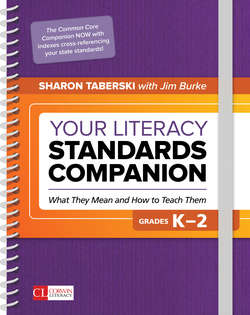Читать книгу Your Literacy Standards Companion, Grades K-2 - Jim Burke - Страница 35
Grades K–2 Common Core Reading Standard 2: What the Teacher Does
ОглавлениеTo have students determine the central ideas, message, or main topic of the text:
Make talking about the central or main message (literature) and main topic (informational) a routine part of what you do when you read aloud to students or confer with them.
Think aloud about how you determine the author’s central message and main topic, and point out the details—words, sentences, and illustrations—that helped you reason and infer.
Share big books or enlarged texts with students and have them participate in figuring out the author’s central message or main topic by attending to specific words, phrases, and images in the text.
Plan lessons that demonstrate how the illustrations in both literature and informational text help readers figure out and elaborate on the central message or main topic. Repeat similar lessons throughout the year in which students study illustrations to glean information.
Guide students to consider how the title, headings, pictures/captions, and bold words in an informational text help readers figure out the main topic, pointing out to students when the author plainly states the main idea in a paragraph’s first sentence and other places.
To have students analyze the development of the central message:
Help students to recognize that focusing on the elements of story grammar (i.e., character, setting, problem, main events, and resolution) is one of the most effective ways to determine how a story is developing. Use a story grammar graphic organizer to illustrate this point (resources.corwin.com/literacycompanionk-2).
Give students regular practice in thinking and talking about the main character in a story they’re reading on their own. For example, they might think about the problem that character has, how other characters support the main character or stand in his or her way, and how the main character eventually solves the problem or resolves the conflict.
To have students retell or recount stories, including fables and folktales:
As you read aloud, introduce students to different types of stories, such as realistic stories, adventure stories, graphic novels, folktales, and fantasy stories. Give students opportunities to discuss them and then compare and chart the attributes of the different types.
After a story has been read a couple of times, demonstrate how to retell/recount it. First, explain that a retell/recount involves an opening statement, followed by key events listed in sequential or chronological order, and a conclusion. Have students practice retelling/recounting stories orally by working with partners and then sharing with the class.
Engage students in an activity called “Story Bookends,” in which a story is read aloud and then students decide on the problem the main character is experiencing (the left bookend) and the resolution (the right bookend). Two students then illustrate the bookends on separate pieces of chart paper. Next, engage the entire class in a discussion of the “events” that should go in the middle, and ask for volunteers to represent or stand in for each “event.” Line up the students representing the two “bookends” and the “events” in the front of the classroom in chronological order and have them describe how the problem is resolved.
To have students identify the main topic of an informational text and recall key supporting details:
Help students understand that by attending to the title and the front and back cover illustrations, readers can get a general sense of what a text is about.
Direct students to pay close attention to section titles, words in bold, and illustrations before, during, and after they read.
Help students identify words that are repeated frequently, since these often refer to the key details the author wants readers to know.
To have students identify the focus of a specific paragraph within a multiparagraph text:
Teach students what a topic sentence is and how it most often comes at the beginning or end of a paragraph.
Think aloud your process for noticing special vocabulary or repeated/related words that provide clues to the main topic, such as eat, meal, plants, diet, and feeding in a paragraph whose main topic is “what deer eat.”
Give students practice in locating topic sentences and identifying the details that support them. Project a paragraph on a whiteboard, think through with students’ help what the topic sentence might be, and then underline or annotate the key details.
To help your English language learners, try this:
Bring in actual bookends (realia) to help make the “Story Bookends” activity more concrete.
Make certain that students understand the academic vocabulary you’re using, such as the terms main character, problem, and resolution.
Have students work in small groups to practice retelling stories orally. Use pictures as props to help students’ retellings. Encourage students to act out the stories.
Have students work in small groups to practice sharing main ideas and details orally from nonfiction text. Use pictures as props to help them describe the main topics and supporting details, pointing to the text as appropriate to show where in the text the information is presented.
Developmental Debrief:
Since teaching students to summarize officially begins in third grade, we do not address this skill per se in this K–2 volume. However, retellings/recounts are on the developmental continuum leading toward students eventually learning to summarize in later grades.
In K–2 classrooms, it is advisable for students to talk about the central message in a piece of literature rather than try to determine its “theme,” a concept that’s more appropriate for students in grade 3.
